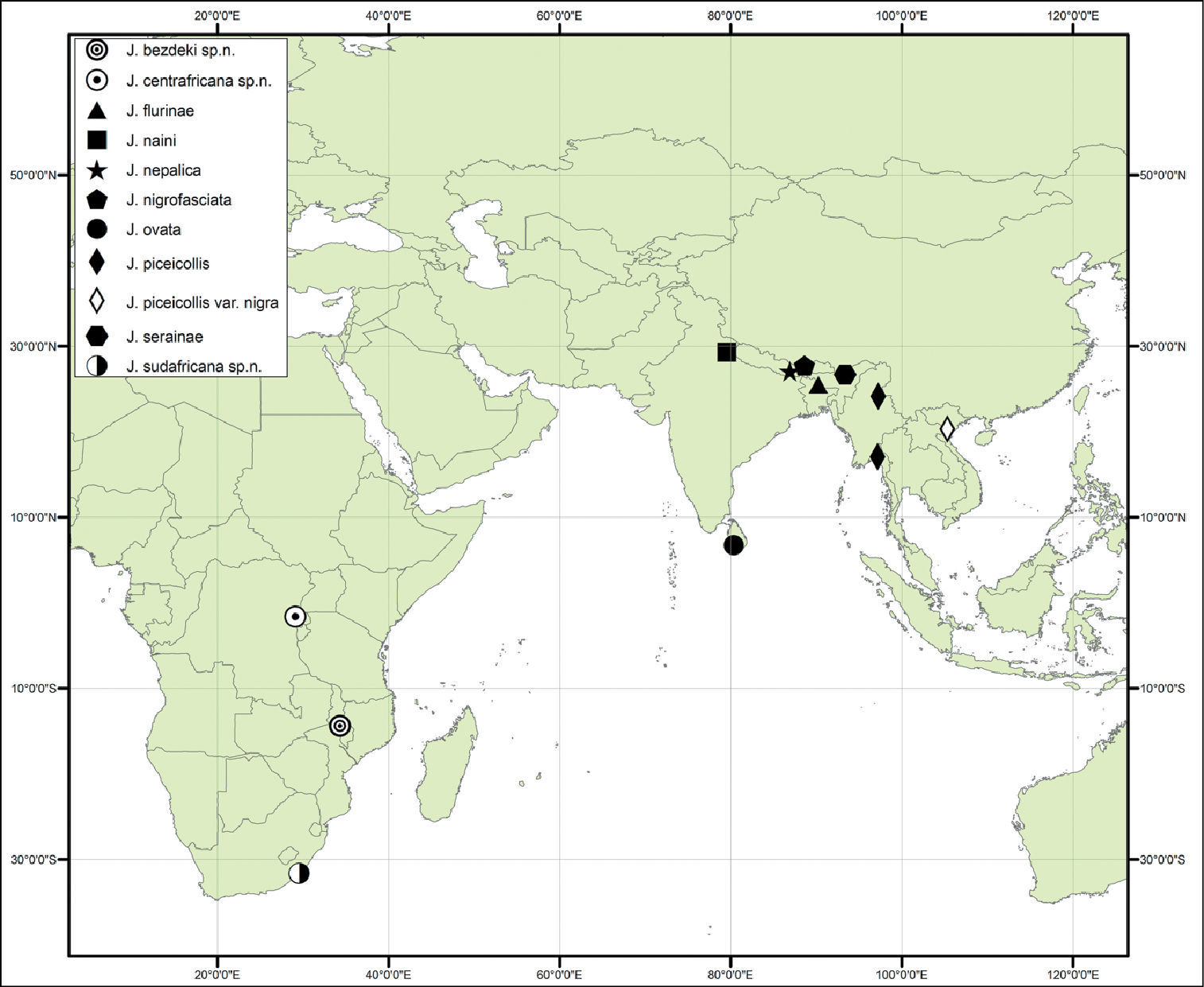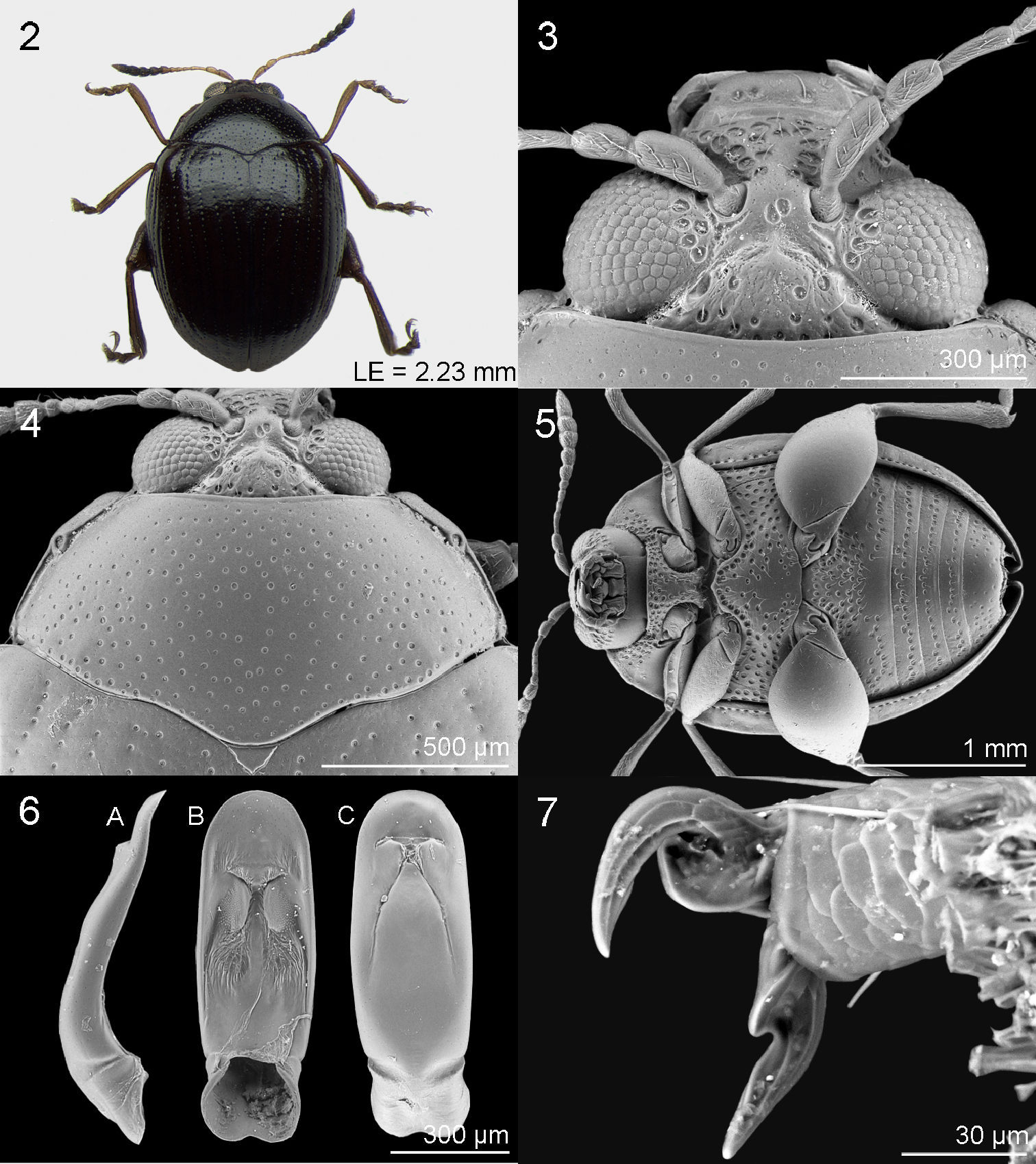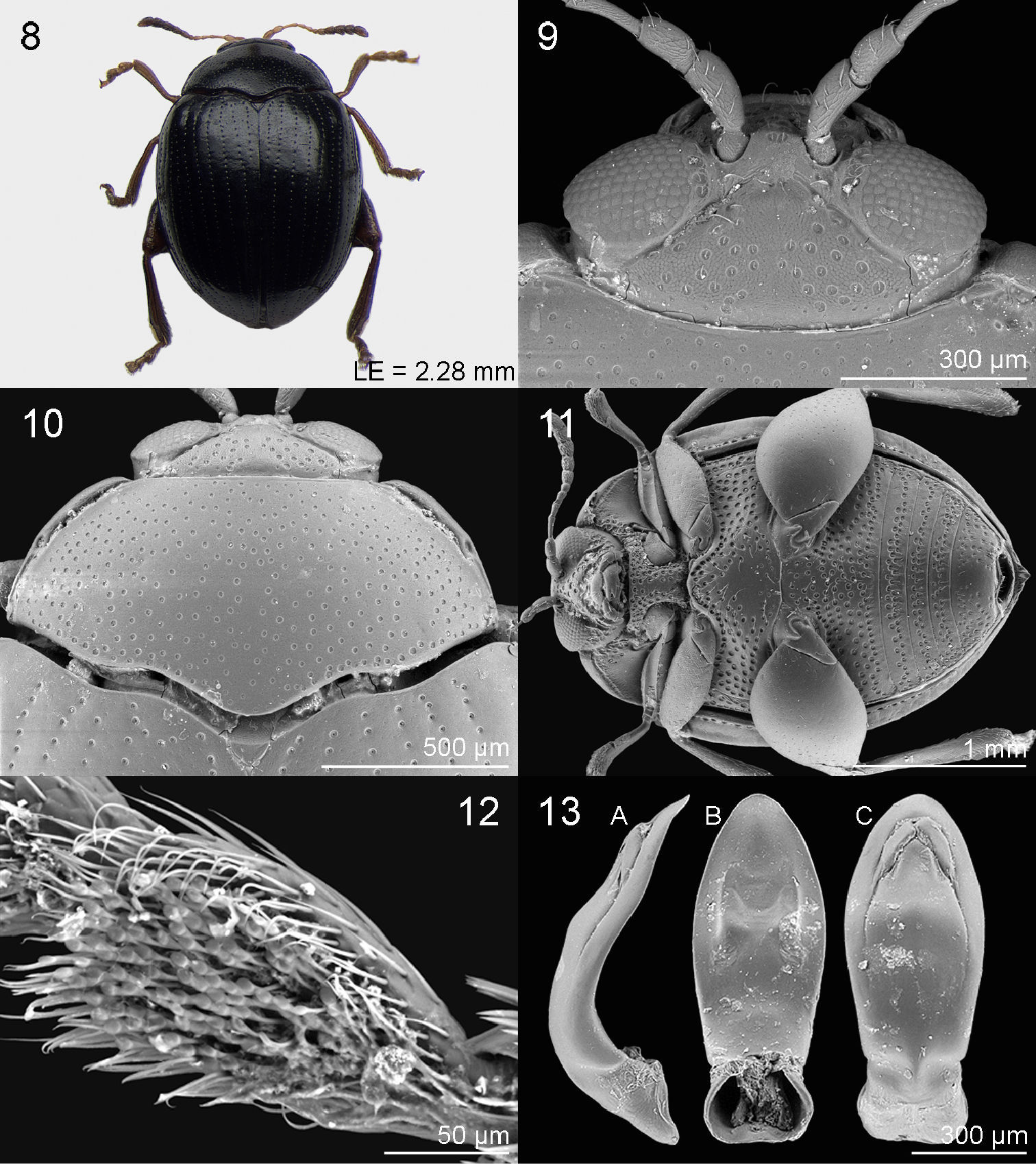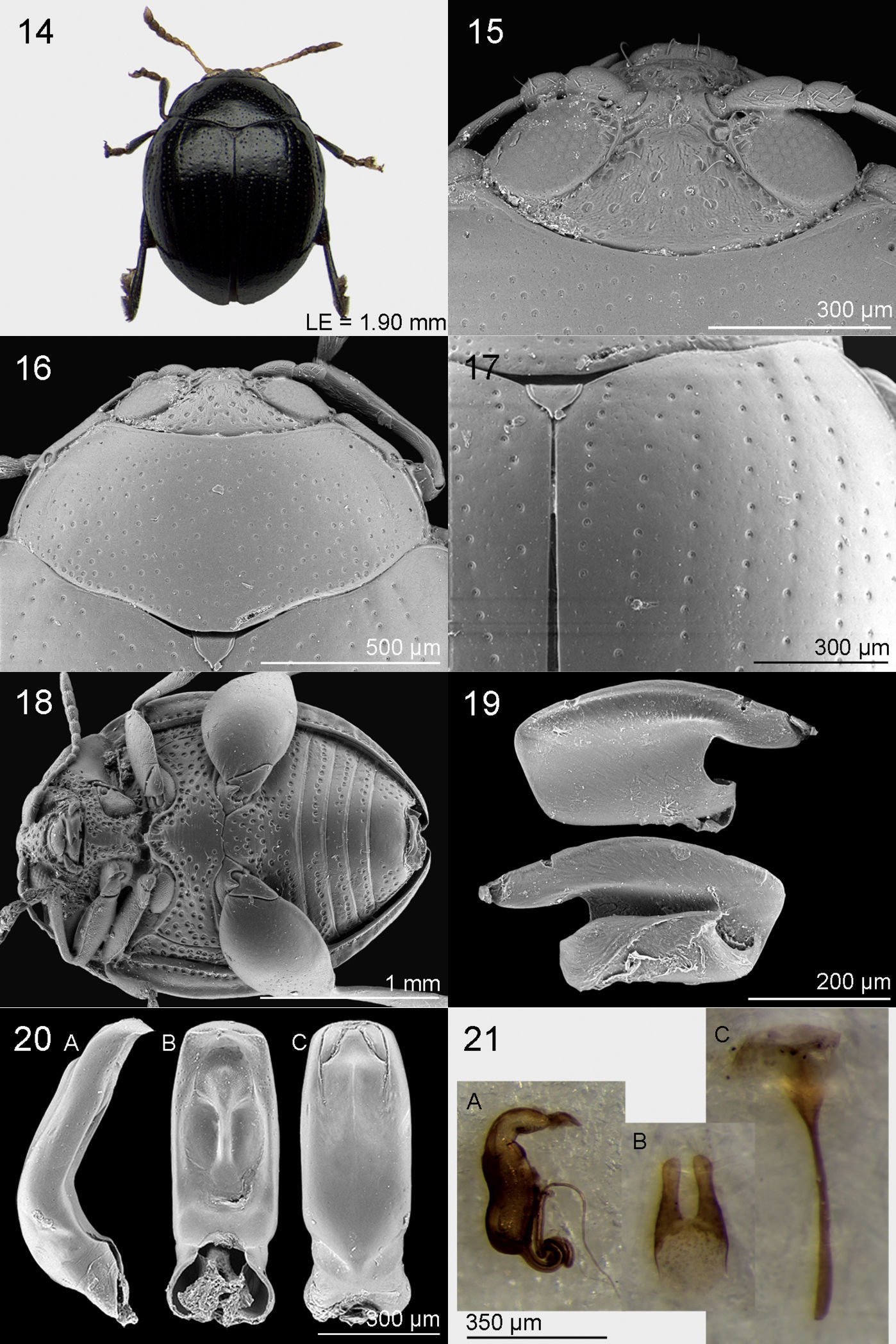(C) 2010 Maurizio Biondi. This is an open access article distributed under the terms of the Creative Commons Attribution License, which permits unrestricted use, distribution, and reproduction in any medium, provided the original author and source are credited.
For reference, use of the paginated PDF or printed version of this article is recommended.
An Orientalflea beetle genus Jacobyana Maulik, 1926 including 7 species from India, Nepal, Vietnam and Sri Lanka, is reported in the Afrotropical Region for the first time. It is represented there by three new species, Jacobyana bezdeki sp. n., Jacobyana centrafricana sp. n., and Jacobyana sudafricana sp. n. Micrographs of male and female genitalia, scanning electron micrographs of some diagnostic morphological characters, a key to identification and distributional data for the new species, are provided.
Afrotropical Region, Oriental Region, Chrysomelidae, Alticinae, Jacobyana, new species
The flea beetle genus Jacobyana was described by
In this paper we report the first records of Jacobyana for Sub-Saharan Africa and describe three new species: Jacobyana bezdeki sp. n., from Malawi, Jacobyana centrafricana sp. n., from Democratic Republic of Congo, and Jacobyana sudafricana sp. n., from Republic of South Africa. This extends considerably the geographical distribution of Jacobyana and widens already important Oriental component in the Afrotropical flea beetle fauna (
The Afrotropical Region, in fact, shares the highest
number of flea beetle genera with the Oriental Region (26 of 102 genera
in total) (
Material consisted of dried insects preserved in the institutions listed below. Further faunistic data on the Jacobyana species in Sub-Saharan Africa were collected during zoological collecting trips that were part of an Italian research project (PRIN 2004057217) aimed at interpreting the disjunct distribution of different plant and animal groups in the Mediterranean-South African regions. Specimens were examined and dissected using WILD MZ12.5 and LEICA M205C binocular microscopes. Photomicrographs were taken using a Leica DFC500 camera and the Auto-Montage Pro 2006 software (license number: 15224*syn2459*153a2112_maurizio_266836). Scanning electron micrographs were taken using a HITACHI TM-1000. Geographical coordinates of the localities are reported in degrees and minutes (DMD-WGS84 format); those included in square brackets were added by the authors.
Abbreviations. Morphology. LAED: length of median lobe of aedeagus; LAN: length of antennae; LB: total length of body; LE: length of elytra; LP: length of pronotum; LSP: length of spermatheca; WE: width of elytra; WP: width of pronotum.
Collections and depositories. BAQ: collection of M. Biondi preserved in the Dipartimento di Scienze Ambientali, University of L’Aquila, Italy; BMNH: The Natural History Museum, London, United Kingdom; SANC: South African National Collection, Plant Protection Research Institute, Pretoria, Gauteng, Republic of South Africa; TMSA: Transvaal Museum, Pretoria, Gauteng, Republic of South Africa.
TaxonomySphaerophysa piceicollis Jacoby, 1889: 195, by original designation. (Type locality: Burma).
Based on newly examined material, morphological characteristic of Jacobyana is revised and updated with respect to the original description (
Metafemoral spring (Fig. 19) similar to springs of Psylliodes morpho-group (Furth & Suzuki 1998) but likely constitutes a new morpho-group with dorsal lobe regularly curved, with rather long extended arm; basal edge straight, angled < 90° with central axis of dorsal lobe; dorsal edge of ventral lobe straight; basal angle of ventral lobe acute, short, apically pointed; recurve flange distinctly sclerotized.
Oriental (India, Nepal, Vietnam and Sri Lanka) (
Geographical distribution of the genus Jacobyana Maulik.
Jacobyana bezdeki sp.n. (LB = 2.64 mm), Jacobyana centrafricana sp. n. (LB = 2.66 mm), and Jacobyana sudafricana sp.n. (LB ♂ = 2.25 mm and ♀ > 2.43 mm) are the smallest species of the genus (
urn:lsid:zoobank.org:act:8429491E-26FC-469C-B106-8B97C94A3D4B
Holotype ♂: MALAWI: Dedza env. [~ 14°23'S, 34°19'E], 06–13.i.2002, J. Bezděk leg. (BAQ).
Jacobyana bezdeki sp. n. is different from Jacobyana centrafricana sp.n. and Jacobyana sudafricana sp.n. in having dorsal integuments reddish-brown (integuments are entirely or almost entirely black in Jacobyana sudafricana sp. n. and black with reddish elytral apex in Jacobyana centrafricana sp.n.). Other distinctive characters are: head with frons and vertex distinctly raised (Figs 3, 9, 15); punctation medially absent in distal part of first abdominal sternite and in last abdominal sternite (Figs 5, 11, 18); median lobe of the aedeagus in ventral view laterally sub-parallel and apically widely rounded (Figs 6, 13, 20).
Holotype ♂. Dorsal integument (Fig. 2) reddish-brown with evident metallic reflection; head, pronotum and elytral punctation darkened. Body elliptical (LB = 2.64 mm), weakly elongate, strongly convex. Maximum pronotal width at base (WP = 1.38 mm); maximum elytral width at basal third (WE = 1.80 mm).
Frons and vertex (Fig. 3) distinctly raised, with clearly wrinkled and punctulate surface and distinct setiferous punctures; frontal tubercles indistinguishable; interantennal space distinctly smaller than length of first antennomere, medially with two jointed setiferous pores clearly impressed on sub-smooth and punctulate surface; frontal carina not raised; clypeus triangular with large setiferous punctures; labrum sub-rectangular, reddish; palpus yellowish; eye sub-elliptical, normally sized; antenna much shorter than body length (LAN = 0.94 mm; LAN/LB = 0.36), with antennomeres 1–6 entirely pale, antennomere 7 partially darkened, antennomeres 8–11 clearly darkened; antennomeres 1–2 and 7–11 clearly enlarged; length of each antennomere proportional to numerical sequence 22:13:18:9:9:8:12:11:12:12:23 (right antenna).
Pronotum (Fig. 4) sub-trapezoidal, strongly transverse (LP = 0.66 mm; WP/LP =2.08), laterally clearly and evenly rounded, basally as wide as elytra; basal margin distinctly sinuous, not bordered; lateral margin distinctly bordered, with anterior setiferous pore rearward little before middle of pronotal side; punctures densely and uniformly distributed on very finely and sparsely punctulate surface; punctures small but clearly impressed. Scutellum very small, sub-triangular, with sub-smooth surface.
Elytra moderately elongate (LE = 2.23 mm; LE/LP = 3.36), covering entire pygidium, laterally clearly arcuate, apically jointly rounded; punctures small but clearly impressed, arranged in 9 regular rows (+ 1 short scutellar row); surface sub-smooth with dense punctulation; interstriae flat; humeral callus very weakly prominent; macropterous metathoracic wings.
Legs with partially darkened femur and reddish tibia and tarsi; hind tibia straight without dentate external margin; apical spur of hind tibiae short, reddish. First anterior and middle tarsomeres slightly dilated with adhesive setae on ventral side (Fig. 12).
Ventral parts (Fig. 5) dark-brown, with dense and rather uniformly distributed setiferous punctures, but medially sparser or absent on prosternum, metasternum, distal part of first abdominal sternite and last abdominal sternite; last abdominal sternite without special preapical impressions.
Median lobe of aedeagus (Fig. 6) short and robust (LAED = 0.91 mm; LE/LAED = 2.44), in ventral view laterally sub-parallel, apically widely rounded; ventral sulcus very wide, clearly impressed, with partially wrinkled surface and two paired short longitudinal carinae and numerous small protruding structures; dorsal sulcus poorly-developed; dorsal ligula well-developed, apically acute; median lobe in lateral view clearly arcuate at basal third and slightly sinuous in apical part; surface of median lobe with pores, especially on ventral side of apical part.
Jacobyana bezdeki Biondi & D’Alessandro, sp. n. ♂, holotype (Malawi). 2 habitus 3 head 4 pronotum 5 ventral parts 6 median lobe of aedeagus, in lateral (6A), ventral (6B), dorsal (6C) view 7 tarsal claws.
This species is named after its collector J. Bezděk (Czech Republic), valued specialist of Chrysomelidae.
Malawi (Fig. 1). Eastern Afrotropical chorotype (EAF) (
Host plant is unknown.
urn:lsid:zoobank.org:act:55ECC82E-16CE-4D8D-BABD-EE02D92840BF
Holotype ♂: ZAIRE [= REPUBLIC OF CONGO]: Nord Kivu, Lac Mugunga [~ 1°37'S, 29°32'E], 1520 m, 16.vii.1990, G. Carpaneto & S. Zoia leg. (BAQ).
Jacobyana centrafricana can be distinguished from Jacobyana bezdeki sp. n. and Jacobyana sudafricana sp. n. by the following features: the dorsal integuments being black with elytral apex clearly reddish and legs distinctly paler (reddish-brown in Jacobyana bezdeki sp. n.; more diffusely black in Jacobyana sudafricana sp. n.); the basal margin of the pronotum is slightly more sinuous (Figs 4, 10, 16); punctures of the ventral side of the body more densely impressed (Figs 5, 11, 18); the median lobe of the aedeagus in ventral view is clearly lanceolate, laterally with the maximum width about middle and with acutely rounded apex (Figs 6, 13, 20).
Holotype ♂. Dorsal integument (Fig. 8) entirely black with evident metallic reflection; elytral apex clearly reddish. Body roundish (LB = 2.66 mm), strongly convex. Maximum pronotal width at base (WP = 1.39 mm); maximum elytral width at basal third (WE = 1.88 mm).
Frons and vertex (Fig. 9) with clearly shagreened and punctate surface, and distinct setiferous punctures; frontal tubercles subtriangular, blackish, very scarcely delimited, with shagreened surface; frontal grooves distally deep, particularly along ocular margin; interantennal space distinctly narrower than length of first antennomere, medially with two setiferous pores; frontal carina not raised; clypeus triangular with large setiferous punctures; labrum sub-rectangular, distally brownish; palpus yellowish; eye sub-elliptical, normally sized; antenna much shorter than body length (LAN = 1.00 mm; LAN/LB = 0.38), entirely pale, but with antennomeres 8–11 clearly blackened; antennomeres 1–2 and 7–11 clearly enlarged; length of each antennomere proportional to numerical sequence 23:14:20:10:9:8:14:14:16:16:20 (right antenna).
Pronotum (Fig. 10) sub-trapezoidal, strongly transverse (LP = 0.68 mm; WP/LP = 2.06), laterally clearly and evenly rounded, basally as wide as elytra; basal margin distinctly sinuous, not bordered; lateral margin distinctly bordered, with anterior setiferous pore rearward at middle of pronotal side; punctures densely and uniformly distributed on shagreened and very finely punctulate surface; punctures small but clearly impressed. Scutellum very small, half-roundish, with sub-smooth surface, medially clearly depressed.
Elytra moderately elongate (LE = 2.28 mm; LE/LP = 3.37), covering entire pygidium, laterally strongly arcuate, apically jointly rounded; punctures small but clearly impressed, arranged in 9 regular rows (+ 1 short scutellar row); surface sub-smooth with very finely and sparsely punctulation; interstriae flat; humeral callus very weakly prominent; macropterous metathoracic wings.
Legs with blackish femur and tibia but with paler tarsi; hind tibia straight with no dentate external margin; apical spur of hind tibia short, reddish. First anterior and middle tarsomeres slightly dilated with adhesive setae on ventral side (Fig. 12).
Ventral side (Fig. 11) blackish, with very dense and rather uniformly distributed setiferous punctures, sparser or absent in middle part of prosternum, metasternum and last abdominal sternite; last abdominal sternite without special preapical impressions.
Median lobe of aedeagus (Fig. 13) short and robust (LAED = 0.93 mm; LE/LAED = 2.46), in ventral view clearly lanceolate, laterally with maximum width about at middle; apex acutely rounded; ventral sulcus very wide, moderately impressed, without any evident carinae or sulci but medially weakly protruding; dorsal sulcus obliterate; dorsal ligula well developed, apically acutely rounded; median lobe in lateral view basally strongly arcuate at basal third and slightly sinuous in distal half; apex slightly bent in ventral direction.
Jacobyana centrafricana Biondi & D’Alessandro, sp. n. ♂, holotype (Democratic Republic of Congo). 8 habitus 9 head 10 pronotum 11 ventral parts 12 ventral side of first anterior tarsomere in male 13 median lobe of aedeagus, in lateral (13A), ventral (13B), dorsal (13C) views.
This species name refers to the geographic region where it lives and means “from Central Africa”.
Republic of Congo (Nord Kivu) (Fig. 1). Central Afrotropical chorotype (CAT) (
Host plant is unknown.
urn:lsid:zoobank.org:act:2BFA5865-4DA2-41DC-A189-A444C992F2AD
Holotype ♂: REPUBLIC OF SOUTH AFRICA: Eastern Cape Province, Port St. Johns, Silaka Nature Reserve, 31°39.45'S, 29°30.14'E, 10.xi.2006, G. Osella leg. (BAQ). Paratypes: same locality, date and collector as the holotype, 2 ♀♀ (BAQ; SANC); ditto, E. Colonnelli leg., 2 ♀♀ (BAQ; TMSA); South Africa, Pondoland, Port St. Johns [31°38'S, 29°32'E], 29.i-5.ii.1924, R.E. Turner leg., 2 ♀♀ (BMNH).
Jacobyana sudafricana sp. n. is the smallest speciesof the genus (LB ♂ = 2.25 mm); it is also distinctly smaller than Jacobyana bezdeki sp. n. (LB = 2.64 mm) and Jacobyana centrafricana sp.n. (LB = 2.66 mm). The following characters separate Jacobyana sudafricana from the rest African species: pronotal surface laterally slightly depressed (Figs 4, 10, 16); elytra laterally more rounded (Figs 2, 8, 14); punctation of the ventral part medially absent on the last four abdominal sternites (Figs 5, 11, 18); median lobe of aedeagus in ventral view laterally sub-parallel with widely sub-truncate apex (Figs 6, 13, 20).
Holotype ♂. Dorsal integument (Fig. 14) entirely black with evident metallic reflection; tip of elytral apex reddish. Body roundish (LB = 2.25 mm), strongly convex. Maximum pronotal width at base (WP = 1.28 mm); maximum elytral width at basal fourth (WE = 1.71 mm).
Frons and vertex (Fig. 15) with clearly shagreened and finely punctulate surface, with distinct setiferous punctures; frontal tubercles subtriangular, brownish, scarcely delimited, with shagreened surface; frontal grooves distally deep, particularly along ocular margin; interantennal space distinctly narrower than length of first antennomere, medially with two setiferous pores not well delimited; frontal carina not raised; clypeus triangular with large setiferous punctures; labrum sub-rectangular, distally brownish; palpus yellowish; eye sub-elliptical, normally sized; antenna much shorter than body length (LAN = 1.00 mm; LAN/LB = 0.44), entirely pale but with antennomeres 5–11 very slightly obfuscate; antennomeres 1–2 and 7–11 clearly enlarged; length of each antennomere proportional to numerical sequence 18:14:22:11:10:8:12:14:16:16:22 (right antenna).
Pronotum (Fig. 16) sub-trapezoidal, strongly transverse (LP = 0.55 mm; WP/LP = 2.32), laterally clearly rounded, basally as wide as elytra; pronotal surface laterally weakly depressed; basal margin not bordered, sinuous; lateral margin distinctly bordered, with anterior setiferous pore rearward at middle of pronotal side; punctures small but distinctly impressed, few densely but uniformly distributed on very finely and sparsely punctulate surface. Scutellum small, sub-triangular, apically with very small median tooth; surface smooth, anteriorly finely rugose.
Elytra moderately elongate (LE = 1.90 mm; LE/LP = 3.37), covering entire pygidium, laterally strongly arcuate, apically jointly rounded; punctures small and moderately impressed (Fig. 17), arranged in 9 regular rows (+ 1 short scutellar row); surface very finely and sparsely punctulate; interstriae flat; humeral callus very weakly prominent; macropterous metathoracic wings.
Leg entirely reddish-brown with partially blackened femur; hind tibia very slightly curved with no dentate external margin; apical spur of hind tibia short, reddish. First anterior and middle tarsomeres very weakly dilated, with adhesive setae on ventral side (Fig. 12).
Ventral surface (Fig. 18) blackish, with dense and rather uniformly distributed setiferous punctures, medially sparser or absent on prosternum, metasternum and last four visible abdominal sternites; last abdominal sternite without special preapical impressions.
Median lobe of aedeagus (Fig. 20) short and robust (LAED = 0.75 mm; LE/LAED = 2.45), in ventral view laterally sub-parallel in basal 2/3 and slightly convergent in apical third; apex widely sub-truncate; ventral sulcus very wide, clearly impressed, with evident longitudinal median carina distally clearly expanded, with numerous small protruding structures; dorsal sulcus obliterate; dorsal ligula well-developed, apically sub-triangular; median lobe in lateral view very strongly curved at basal third and clearly bent in ventral direction at apex; surface of median lobe with pores, especially on ventral side of apical part.
Jacobyana sudafricana Biondi & D’Alessandro, sp. n. ♂, holotype (Republic of South Africa). 14 habitus 15 head 16 pronotum 17 elytral surface 18 ventral parts 20 median lobe of aedeagus, in lateral (20A), ventral (20B), dorsal (20C) views. Jacobyana sudafricana Biondi & D’Alessandro, sp. n. ♀, paratype (Republic of South Africa). 19 metafemoral spring 21A spermatheca 21B vaginal palpi 21C tignum.
♂ (n = 1): LE = 1.90 mm; WE = 1.71 mm; LP = 0.54 mm; WP = 1.28 mm; LAN = 1.00 mm; LAED = 0.75 mm; LB = 2.25 mm; LE/LP = 3.45; WE/WP = 1.34; WP/LP = 2.32; LE/LAED = 2.53; LAN/LB = 0.44. ♀ (n = 6; mean and standard deviation): LE = 2.25 ± 0.10 mm; WE = 2.01 ± 0.08 mm; LP = 0.65 ± 0.02 mm; WP = 1.46 ± 0.06 mm; LAN = 1.10 ± 0.03 mm; LSP = 0.45 ± 0.02 mm; LB = 2.61 ± 0.10 mm; LE/LP = 3.46 ± 0.08; WE/WP = 1.38 ± 0.02; WP/LP = 2.25 ± 0.08; LE/LSP = 4.96 ± 0.27; LAN/LB = 0.42 ± 0.01.
Paratypes (all females) very similar in shape, sculpture and color to the holotype, but distinctly bigger. Tip of elytral apex variable in color from entirely black to partially reddish. Spermatheca (Fig. 21A) with sub-reniform and elongate basal part, clearly more developed than apical part; apical part with distinct collum and apex; appendix evident; ductus elongate, sub-apically inserted, with several coils in proximal part. Vaginal palpi and tignum as in Fig. 21B, 21C.
This species name refers to the geographic region where it lives and means “from Southern Africa”.
Republic of South Africa (Eastern Cape Province) (Fig. 1). Southern-Eastern African chorotype (SEA) (
Host plant is unknown. Biome: Forest (
| 1 | Dorsal integuments reddish-brown. Frons and vertex distinctly raised (Fig. 3). Median lobe of aedeagus (Fig. 6) short and robust, in ventral view laterally sub-parallel, apically widely rounded; ventral sulcus very wide, clearly impressed; in lateral view basally clearly arcuate at basal third and slightly sinuous in apical part | Jacobyana bezdeki sp. n. |
| – | Dorsal integuments entirely black or with reddish elytral apex. Frons and vertex flat (Figs 9, 15) | 2 |
| 2 | Dorsal integuments black with clearly reddish elytral apex. Abdominal sternites with uniformly and densely impressed punctures (Fig. 11). Median lobe of aedeagus (Fig. 13) in ventral view clearly lanceolate with acutely rounded apex; in lateral view strongly arcuate at basal third and slightly sinuous in distal half with apex slightly bent ventrally | Jacobyana centrafricana sp. n. |
| − | Dorsal integuments entirely black (sometimes only with slightly reddish tip of elytra). Distal abdominal sternites medially without punctation (Fig. 18). Median lobe of aedeagus (Fig. 20) in ventral view apically widely sub-truncate, with ventral sulcus very wide with evident longitudinal median carina; median lobe in lateral view very strongly curved at basal third with apex clearly bent ventrally | Jacobyana sudafricana sp. n. |
We are very grateful to the following friends and colleagues who enabled us to study the valuable material collected by them or preserved in their respective institutions: Jan Bezděk (Mendel University, Brno, Czech Republic), Giuseppe Carpaneto (University of “Roma Tre”, Italy), Enzo Colonnelli (Rome, Italy), Bartolomeo Giuseppe Osella (L’Aquila, Italy), Sharon Lane Shute (BMNH) and Stefano Zoia (University of Milan, Italy).










